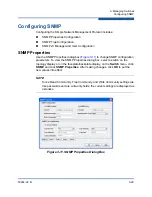
3–Managing Switches
Resetting a Switch
59264-02 B
3-15
Resetting a Switch
Resetting a switch reboots the switch using configuration parameters in memory.
Depending on the reset type, a switch reset may or may not include a Power On
Self Test or it may or may not disrupt traffic.
describes the types of
switch resets.
During a hotreset operation, fabric services will be unavailable for a short period
(30-75 seconds depending on switch model). Verify all administrative changes to
the fabric (if any) are complete before performing an Non-Disruptive Code Load
and Activation (NDCLA). When upgrading firmware across a fabric using non
disruptive activation, upgrade one switch at a time and allow 75 seconds between
switches.
Common administrative operations that change the fabric include:
Zoning modifications
Adding, moving or removing devices attached to the switch fabric. This
includes powering up or powering down attached devices.
Adding, moving or removing ISLs or other connections.
After an NDCLA operation is complete, management connections must be
re-initiated:
QuickTools sessions will re-connect automatically
Telnet sessions must be restarted manually.
Applicable Code Versions:
Future switch code releases will be upgraded non disruptively unless
specifically indicated in its associated release notes
An NDCLA operation to previous switch code releases is not supported.
CAUTION!
Changes to the fabric may disrupt the NDCLA process.
Table 3-3. Switch Resets
Type
Description
Hot Reset
Resets a switch without a Power On Self Test. This reset activates
the pending firmware, but does not disrupt switch traffic. If errors
are detected on a port during a hot reset, the port is reset automat-
ically.
















































